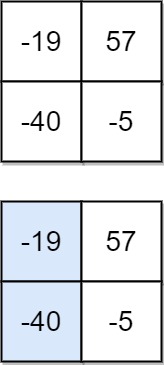931. Minimum Falling Path Sum


Description
Given an n x n array of integers matrix, return the minimum sum of any falling path through matrix.
A falling path starts at any element in the first row and chooses the element in the next row that is either directly below or diagonally left/right. Specifically, the next element from position (row, col) will be (row + 1, col - 1), (row + 1, col), or (row + 1, col + 1).
Example 1:

Input: matrix = [[2,1,3],[6,5,4],[7,8,9]] Output: 13 Explanation: There are two falling paths with a minimum sum as shown.
Example 2:

Input: matrix = [[-19,57],[-40,-5]] Output: -59 Explanation: The falling path with a minimum sum is shown.
Constraints:
n == matrix.length == matrix[i].length1 <= n <= 100-100 <= matrix[i][j] <= 100
Solution
minimum-falling-path-sum.py
class Solution:
def minFallingPathSum(self, matrix: List[List[int]]) -> int:
rows, cols = len(matrix), len(matrix[0])
for i in range(1, rows):
for j in range(cols):
left = matrix[i - 1][j - 1] if j - 1 >= 0 else inf
mid = matrix[i - 1][j]
right = matrix[i - 1][j + 1] if j + 1 < cols else inf
matrix[i][j] += min(left, mid, right)
return min(matrix[-1])